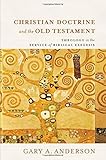Christian doctrine and the Old Testament : theology in the service of biblical exegesis /
Material type: TextPublication details: Grand Rapids, MI, Baker Academic, ©2017.Description: xix, 220 pages ; 24 cmISBN:
TextPublication details: Grand Rapids, MI, Baker Academic, ©2017.Description: xix, 220 pages ; 24 cmISBN: - 9780801098253
- 0801098254
- 230/.0411 23
- BS543 .A53 2017
| Item type | Current library | Collection | Call number | Copy number | Status | Date due | Barcode | |
|---|---|---|---|---|---|---|---|---|
 Books
Books
|
SAIACS General Stacks | Non-fiction | 230.041 A545C (Browse shelf(Opens below)) | C.2 | Available | 067434 | ||
 Books
Books
|
SAIACS General Stacks | Non-fiction | 230.041 A545C (Browse shelf(Opens below)) | Available | 058698 |
Browsing SAIACS shelves, Shelving location: General Stacks, Collection: Non-fiction Close shelf browser (Hides shelf browser)
Includes bibliographical references and indexes.
Part 1: "Who Is a God Like You?" -- Apophatic Theology: The Transcendence of God and the Story of Nadab and Abihu -- The Impassibility of God: Moses, Jonah, and the Theo-Drama of Intercessory Prayer -- Part 2: "In the Beginning" -- Creation: Creatio ex Nihilo and the Bible -- Original Sin: The Fall of Humanity and the Golden Calf -- Election: The Beloved Son in Genesis and the Gospels -- Part 3: "The Word Became Flesh" -- Christology: The Incarnation and the Temple -- Mariology: The Mother of God and the Temple -- Christology: Tobit as Righteous Sufferer -- Part 4: "Conformed to the Image of His Son" -- The Treasury of Merits: Faith and Works in the Biblical Tradition --. Purgatory: Sanctification in This Life and the Next.
The Old Testament offers a rich palette of ideas, images, and narratives that help us unpack some of the more compact and opaque theological ideas of the New Testament. In conversation with both Christian and Jewish interpreters, prominent scholar Gary Anderson explores the exegetical background of key Christian doctrines. Through a deeper reading of our two-Testament Bible, he illustrates that Christian doctrines have an organic connection to biblical texts and that doctrine can clarify meanings in the text that are foreign to modern, Western readers. Anderson traces the development of doctrine through the history of interpretation, discussing controversial topics such as the fall of man, creation out of nothing, the treasury of merit, and the veneration of Mary along the way. He demonstrates that church doctrines are more clearly grounded in Scripture than modern biblical scholarship has often supposed and that the Bible can define and elaborate the content of these doctrines.
There are no comments on this title.







